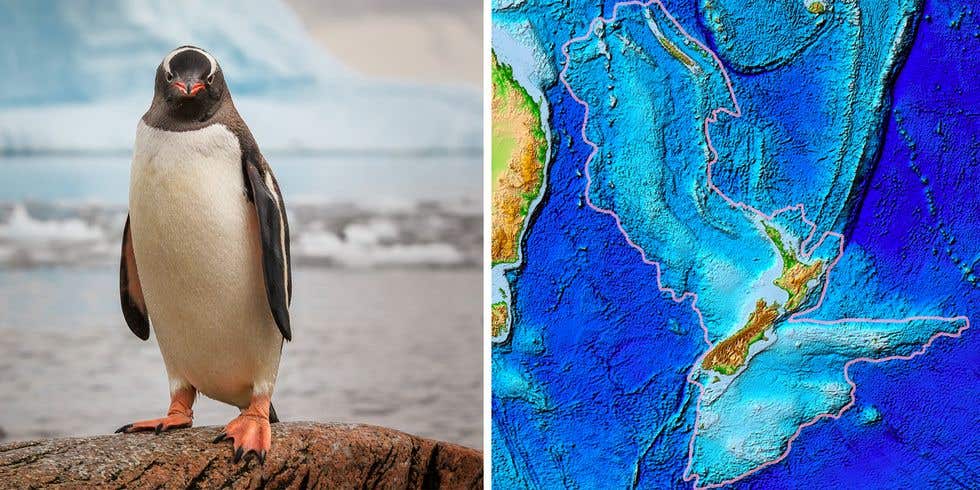Every Penguin in the World Comes from Earth’s Lost Eighth Continent
Researchers love New Zealand’s fossil record of penguins, including giant “monster penguins” that are almost 6 feet tall.

[Oct. 2, 2020: Caroline Delbert]
Researchers have found fossils they say determine almost conclusively that every penguin on Earth originally came from modern-day New Zealand. The small landmass we see today is only the topmost points of a sunken landmass once known as continental Zealandia, backnamed from the Dutch imperialist name for New Zealand: Nieuw Zeeland, not to be confused with the human-built micronation of Sealand.
Zealandia sank about 60 million years ago, meaning it stayed afloat a little longer than the dinosaurs, at least. Penguins date back to about 62 million years ago, and like the Darwinian winners they are, they traveled with the higher ground and survived the fall of Zealandia.
Today, researchers have fossils in hand that date back 3 million years and indicate a previously unknown ancient penguin species. And where penguin species now have wider beaks and jaws, this newly discovered crested penguin shows bone structure indicating a different diet.
“That deep bills arose so late in the greater than 60 million year evolutionary history of penguins suggests that dietary shifts may have occurred as wind-driven Pliocene upwelling radically restructured southern ocean ecosystems,” the researchers, from New Zealand and the U.S., explain in their paper.
This content is imported from {embed-name}. You may be able to find the same content in another format, or you may be able to find more information, at their web site.
Locals first found the fossils and alerted the researchers, who began to excavate and study the penguin specimens. While the specific fossils here are 3 million years old, the scientists say the body of evidence suggests their ancestors date back to that same time frame—60 million years. And even though 3 million years old sounds young compared to 60, the crested penguin fossils still have a beak that shows their different diet compared to today’s penguins.
The fossils are tightly dated, meaning scientists can pinpoint them to a relatively small window of time based on the rock composition surrounding them. And using a biological geography software tool called BioGeoBEARS (BEARS stands for “Bayesian Evolutionary Analysis with R Scripts,” referring to the formulae and programming language in play), these scientists have introduced the 3-million-year-old crested penguin fossil into the larger—and exclusive—evolution of original penguin species on Zealandia.
“[E]arlier studies had only dated the presence of crested penguins on New Zealand back about 7,000 years. The new timeline suggests the region is the penguin’s most likely place of origin.”
The finding isn't necessarily a surprise, but the fossil record is spotty in a way that means not all logically sound theses end up being substantiated by evidence. The researchers write:
“New Zealand is a globally significant hotspot for seabird diversity, but the sparse fossil record for most seabird lineages has impeded our understanding of how and when this hotspot developed.”
Because of its unique position both isolated in geography and as the remnants of an entire former continent, New Zealand has had a special ecosystem even compared with Australia’s unusual flora and fauna spread—more like Madagascar or the Galapagos.
“Our analyses provide a timeframe for recruitment of crown penguins into the New Zealand avifauna, indicating this process began in the late Neogene and was completed via multiple waves of colonizing lineages,” the researchers conclude.
Note: Materials provided above by Caroline Delbert. Content may be edited for style and length.
Like these kind of feel good stories? Get the Brighter Side of News' newsletter.
Joseph Shavit
Head Science News Writer | Communicating Innovation & Discovery
Based in Los Angeles, Joseph Shavit is an accomplished science journalist, head science news writer and co-founder at The Brighter Side of News, where he translates cutting-edge discoveries into compelling stories for a broad audience. With a strong background spanning science, business, product management, media leadership, and entrepreneurship, Joseph brings a unique perspective to science communication. His expertise allows him to uncover the intersection of technological advancements and market potential, shedding light on how groundbreaking research evolves into transformative products and industries.



